Counterfeit batteries: Clever fakes, uncertain risks
posted Wednesday, October 28, 2015 at 5:51 PM EST
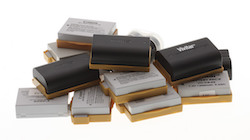
On their website, at their recent Canon Expo, and in their online advertising, Canon U.S.A. has been calling attention to the problem of counterfeit batteries. It's easy to understand Canon's concerns: Besides the obvious issue of lost revenue, companies need to protect their brand reputation, and shoddy batteries and chargers with the Canon name on them (albeit without their permission) would reflect poorly on the company as a whole. There's also the potential that the fake products might be dangerous, though, as counterfeiters will have few compunctions about cutting corners on manufacturing control and safety measures if it would shave a few cents off production costs. Canon also probably recognizes that at least some people who wouldn't consider a third-party battery or charger might buy counterfeits, thinking they're simply getting a good deal on the real thing.
The level of focus Canon, in particular, has been placing on counterfeit batteries and chargers piqued our interest, not only about the counterfeits, but about the very low-cost third-party batteries you can find on Amazon and eBay. What are the real differences between both categories of products and the genuine articles? Are they really dangerous? Are inexpensive third-party batteries worth their price?
To take a look, we went online and bought about 20 samples of batteries advertised as "Genuine Canon" on eBay, but that were being sold for prices too good to be true. We concentrated on the most-frequently counterfeited Canon batteries, namely the LP-E6, used in many popular Canon SLRs like the 7D, 5D Mark III, and other pro- and semi-pro models, and the LP-E8, no longer used in current camera models, but the mainstay of Canon consumer SLRs for years (from the T2i through the T5i). We also bought a single pair of counterfeit Nikon EN-EL15 batteries, the battery used in Nikon's mid-range SLR models like the D7200, D810, and D750, just to see what at least one counterfeit sample of a popular model from another manufacturer looked like.
What's the big deal with counterfeit batteries?
Counterfeit batteries are just a tiny blip in the overall counterfeiting landscape, but they're the one that probably affects us photographers most directly. We all have an image in our mind of the shady guy selling "genuine Rolex watches" out of his trenchcoat on a New York streetcorner, but until I researched this article, I didn't realize just how big the counterfeiting problem is. In 2014, the US Department of Homeland Security (which now handles Customs functions in the US) reported seizing 23,140 shipments of counterfeit goods, with a total retail value of more than $1.2 billion dollars. Even that's probably just the tip of the iceberg, though, given that it only represents the goods DHS managed to intercept. When you consider how many counterfeit items likely come into the country in small packages from overseas sellers (like all the counterfeit batteries we bought on eBay for this article), or that arrive in containers the Customs inspectors just don't have time or resources to inspect, the actual total must be much, much higher.
Besides the obvious impact of counterfeits on legitimate jobs, some fake products can be actively dangerous. Camera batteries obviously aren't in the same category as counterfeit drugs or contaminated food products, but we've all seen photos of melted-down computers and cell phones and videos of burning batteries on the Internet. Lithium-ion (Li-ion) batteries pack a lot of energy into a small space, and lithium is a highly reactive element. An overload, overcharging, physical shock or a manufacturing defect can lead to "thermal runaway". When things go wrong (like an internal short circuit), the battery's chemicals break down and react, releasing large amounts of heat. High temperatures make the chemical reactions go even faster, creating even higher temperatures, so things rapidly get worse. This is called "thermal runaway", and a burning Li-ion battery can hit temperatures of 1,000-1,500F (600-800C) in seconds.
Even major manufacturers have had safety problems
Thermal runaway problems are what's behind all the burning-computer videos we've all seen on YouTube. In the US, the CPSC (Consumer Protection Safety Commission) has logged more than 40 product recalls for lithium batteries in the last 12 years, from companies as prestigious as Acer, Apple, Dell, Fujitsu, Gateway, HP, Nikon, Sony, and Toshiba, all based on reports of spontaneous meltdowns. You can be pretty sure that these companies have been building battery packs to the highest standards, with good designs, QC procedures and protective circuitry built in, yet they all suffered instances of batteries catching fire.
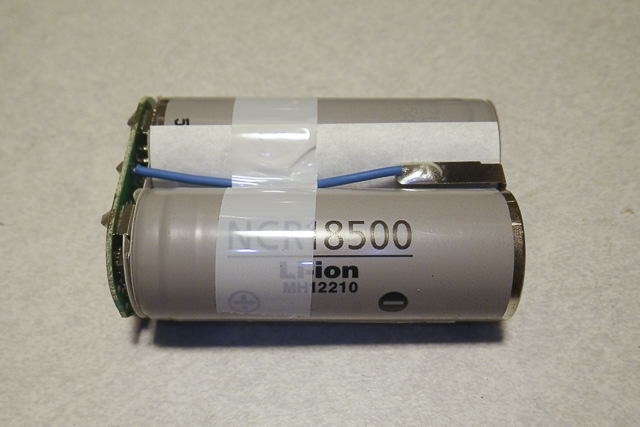
If mainstream companies like Apple and Sony have had problems with Li-ion batteries, how much more likely is it that an internet counterfeiter selling dirt-cheap knockoffs would have them? And of course, forget about a recall notice; even if they cared, counterfeiters aren't about to call attention to their illegal activities by announcing problems with their products.
The multiple product recalls by even legitimate manufacturers suggest that lithium-ion batteries are delicate and dangerous beasts: what needs to be done to make them safe?
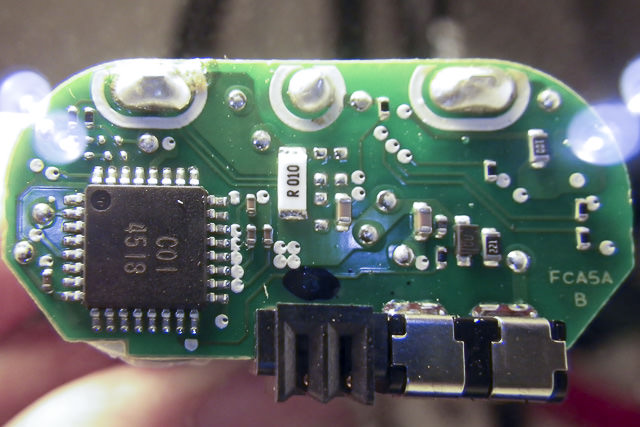
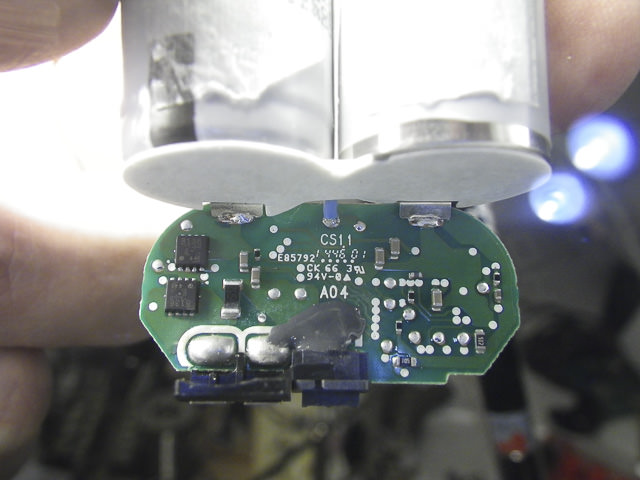
Protection circuitry: Save the cells!
The first step is to protect the individual lithium cells inside the battery pack against electrical abuse from the outside. The first line of defense is protective circuitry that sits between the battery pack and the outside world. These circuits prevent too-high current drain, too-low discharge voltage, and too-high charging voltage from reaching the battery cells themselves. There are a host of ICs on the market that do this, and fortunately, all of the counterfeit samples we examined had at least some kind of protective circuitry inside. (Although some allowed the charging voltage to rise to the point that could cause cell damage.)
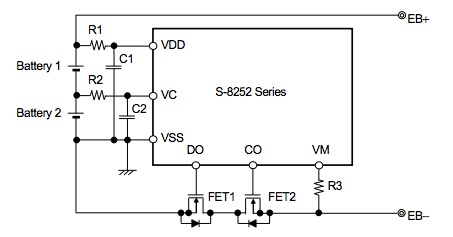
Even though we found protection circuits in all the counterfeits that we cracked open, that doesn't mean that every fake product you might find on eBay will, and I still wonder a bit about the reliability of the units we tested and tore apart: Counterfeit integrated circuits are every bit as rampant in China as counterfeit batteries, so there's no telling if the circuits inside the batteries we examined were actually manufactured by the companies whose names they bore. (And as noted, some batteries we tested had cutoff voltages well into the range that would result in permanent damage to the cells and shortened life.)
When good cells go bad...
Of course, external protection circuits are no help if the battery cells themselves fail. If an internal short happens, pressure-relief vents (which cheap cells may not have) plus a carefully controlled manufacturing process and quality checks will help reduce the risks of an explosion.
Lithium-ion batteries are simple in concept, but manufacturing them requires careful design and rigorous monitoring and control of the manufacturing process if you're to achieve good capacity and safe operation. The encyclopedic Electropaedia site lists no less than 15 categories of potential manufacturing problems for lithium batteries. Combine that with the site author Barrie Lawson's often-hilarious account of Buying Batteries in China, and it's frankly amazing that we don't see more cases of exploding batteries on the nightly news. (If you have a few minutes, do check out his Buying Batteries in China piece; some of it's truly LOL material :-)
Other problems with counterfeit batteries
Of course, safety isn't the only issue with counterfeits, or for that matter with third-party "compatible" products. Charge capacity comes down to the luck of the draw. Based on our limited testing, you may get something close to stated capacity, or you may get less than half: The worst counterfeits we tested had only 43% the capacity of the genuine products. And this was when they were brand new: User reviews of some third-party batteries on Amazon report run-times of as little as 10 minutes when recording video, even from gently-treated battery packs.
Another result of a battery maker cutting corners is high cell resistance. You wouldn't be able to detect this without test equipment (the output voltage drops more when it's placed under load), but high internal resistance means the battery can heat up a lot more than usual, especially when it's supplying more current. If you start out with a camera and battery that have been sitting in a hot car, and then try to record video or fire off hundreds of shots in quick succession, a battery with high internal resistance could edge over into the danger zone.
Sourcing counterfeits
We wanted to get some idea of what was out there in counterfeit-battery land, so purchased a number of samples through both eBay and Amazon. To their credit, we didn't see any signs of counterfeit sales through Amazon or others selling through their pages, but we did purchase a couple of different brands of third-party replacement packs through them that were, uh ... "less than stellar" in their performance. We concentrated mainly on Canon LP-E8 and LP-E6 batteries, as these are apparently two of the most widely counterfeited products. We also purchased a couple of fake Nikon EN-EL14s, just to have a sample of some other brand being targeted by counterfeiters.
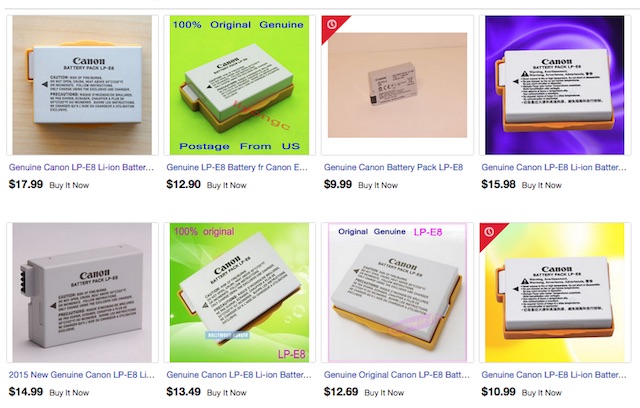
As you might expect, eBay is the Wild West, when it came to counterfeit battery products. We found many sellers there offering what they claimed were genuine Canon (or other) batteries at prices that were just too low to be real. Interestingly, while we found many US-based sellers offering fake LP-E8 batteries they claimed to be genuine, it seemed that the only sources of LP-E6 packs were sellers shipping from China. (Maybe Canon and US Customs have cracked down more on LP-E6 counterfeits?)
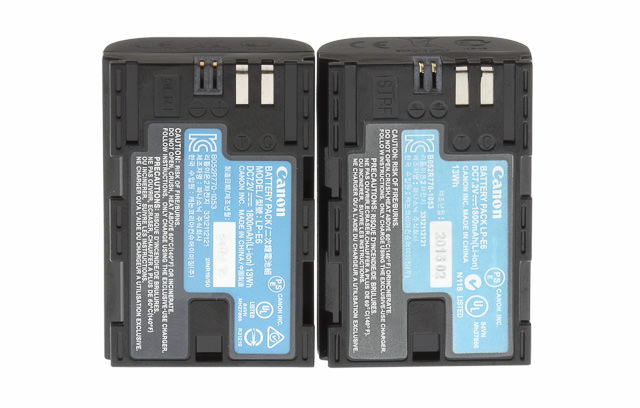
(The battery on the left in the above photo is the genuine Canon.)
Other than a few obvious images that didn't look at all like the genuine articles, it was pretty much impossible to tell the fakes from the real things, based on eBay photos. Photos there were either too low-quality, or possibly not even of the products being sold, to detect any difference. For that matter, even after getting the samples in-house and looking at them close-up, differences were often very subtle.
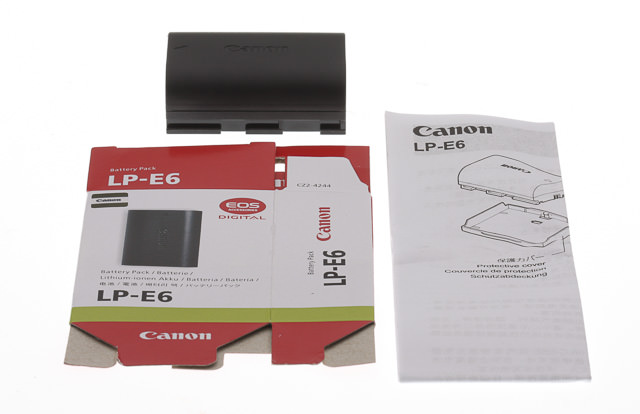
What was amusing, though, was how little effort some of the makers made to maintain the "genuine" impression. Many batteries came in just a padded envelope and plastic bag, with no manufacturer-branded packing material, but several arrived with replica Canon retail boxes and safety-instruction inserts just tossed in bags with the batteries themselves. The boxes were folded flat; I guess it would have cost another penny or two, to actually open the boxes and stuff the batteries and safety-warning papers inside, to make them look like they actually came from Canon. (The two Nikon batteries arrived the same way, with folded-flat packaging.)
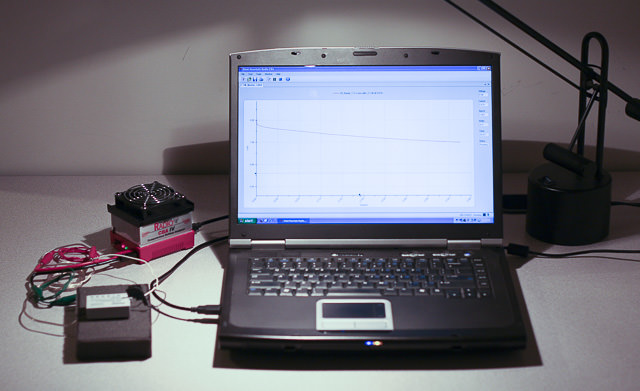
Our (limited) tests
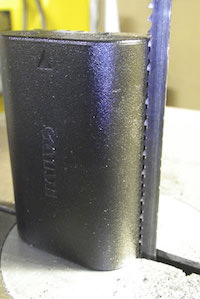
This was pretty much a spare-time project (yeah, right, "spare" time?), so we couldn't devote a lot of time to testing, but we did run 28 different batteries (both genuine and fake) through a couple of charge/discharge cycles, to measure their capacity. Capacity (in mAh) was all over the map, ranging from a low of a bit under 43% to 99%, with many in the range of 60% or so. As noted below, though, these were only as-new capacity numbers, and a significant measure of battery quality is how well they maintain their capacity over time.
We also cracked open a number of the battery packs, as shown in the photo above. (Seriously, don't try this at home!) We found that about the only way to crack open the cases was to very carefully slice along the seams with a bandsaw. This was a very painstaking process, because we knew that cutting into the cell bodies themselves would almost certainly result in smoke and flames. (No joke; puncturing a Li-Ion battery will amost inevitably lead to an internal short, thermal runaway, and the resulting violent smoke and flames.)
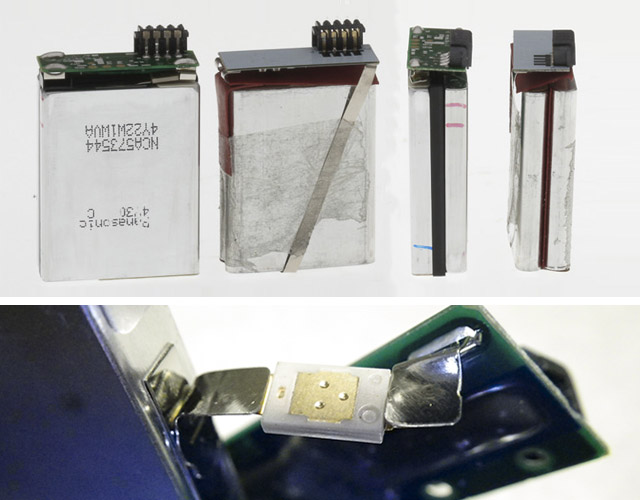
What we found inside was again a mixed bag. In general, the genuine samples showed better construction techniques, especially the Canon LP-E8s vs their knock-off competitors. The Canon LP-E8s had very obviously more robust internal connections, more layers of insulating tape and spacers, what appear to be fuses in the leads coming off of each cell, and a plastic separator. Compared to the competition, they looked much more carefully constructed. The Canon LP-E8s also used Panasonic cells internally; Panasonic being a world leader in Li-Ion manufacturing.
The LP-E6s showed less obvious differences, although the genuine products once again had more robust, heavier solder joints, and interestingly, their contacts for power and communications were part of the protection-circuit circuit board, slipping easily out of the outer casing. The counterfeit and third-party units all had wires connecting directly to contacts lodged in the case, requiring wires and connections to be cut, to free the battery and protection circuitry from the case.
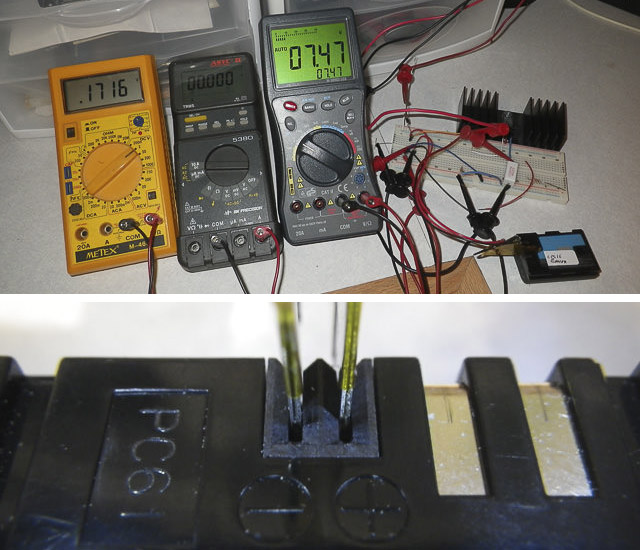
We tested the batteries in two ways. I used some of my electronics gear to experiment with overcurrent and overvoltage cutoff limits, and we used the West Mountain Radio tester shown earlier to measure capacity and undervoltage cutoff under load.
As noted earlier, we found at least some form of protective circuitry in all of the packs we opened, and as far as we could tell, they operated as they should in the case of overcurrent and overdischarge (trying to pull too much current from the battery or to discharge it below the point at which the cells would be damaged.)
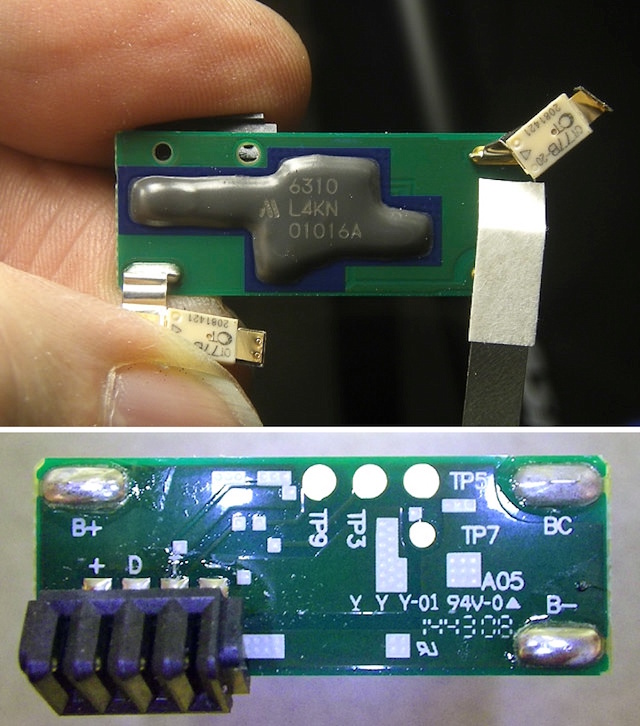
The more dangerous case is overcharging, though, meaning continuing to charge the battery beyond its "full" condition. In the case of Li-ion cells, this means not stopping the charge at the correct voltage. The standard for the types of cells used in most camera batteries is 4.2 volts/cell, or 8.4 volts for the pack. If you charge beyond that point, two things happen. First, lithium metal begins plating out on the graphite anode, which can drastically shorten the battery's life. Secondly, though, the plated lithium doesn't get deposited smoothly, so the "dendrites" that are often formed can lead to internal shorts and thermal runaway.
Of the batteries we tested, the protection circuitry in one failed to disconnect the battery from the charger, even when the voltage for the pack as a whole reached 8.7 volts. (4.35 volts per cell) I didn't want to push my luck, so stopped the test at that point, not wanting to risk an explosion in my electronics lab. Even though it didn't explode, that battery's capacity is likely now permanently reduced, due to lithium plating on the anode.
We don't know if the pack with the bad over-voltage circuitry would have exploded if we'd kept on with the test, or if it would eventually have cut out at some voltage higher than we were willing to tempt the fates with. It's clear, though, that the combination of a battery like that with an over-generous overvoltage limit and a poorly-designed charger could result in an abnormally short battery life.
Notably, all the brand-name batteries we tested (several Canon LP-E6 and LP-E8s, as well as a pair of Nikon EN-EL15s) were conservative in their over-voltage cutoff points, staying within accepted limits. It was only the counterfeit and third-party units where we saw cutoff voltages noticeably higher than recommended levels. (Too-high cutoff voltages can boost initial capacity, but at a severe cost in longevity.)
Need to make it cheap? Just leave stuff out!
There are a lot of ways a battery maker can cut corners with the cells themselves that you'd never see, even if you took the packs apart like we did. There was one obvious trick, though, that we found particularly amusing: An easy way to save on production costs is to simply not put as much battery-stuff inside the case!
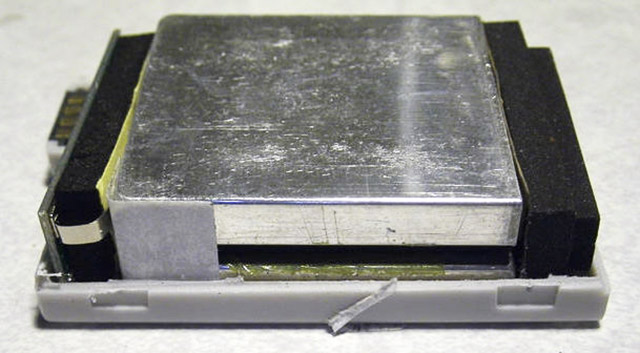
We'd heard of this tactic by counterfeiters, but actually encountered it in two third-party replacement samples. The less egregious of the two was an LP-E8 replacement pack, with noticeably smaller cells than those in the official versions. The extra space in the case was taken up with foam padding. (To add insult to injury, this maker also showed a higher mAh rating on the case than Canon's own.)
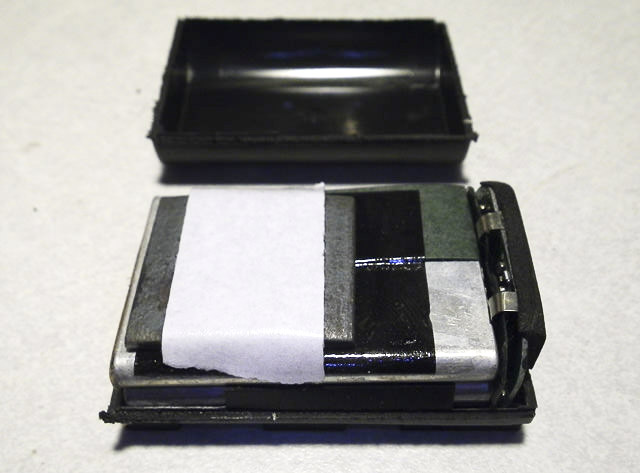
The real corker came when we cracked open an LP-E6 replacement pack from the same maker. Real LP-E6s have two beefy cylindrical cells crammed into the case, with no room to spare. This third-party unit instead had two thin rectangular cells in their place, filling maybe half the volume inside the case. Of course, with that much less battery inside, the packs would feel suspiciously light in the hand. The solution? Just tape a steel weight on top, to bring the weight up to where it should be!
An easy tipoff to dishonest third-party battery sellers
It's not uncommon to see third-party batteries advertised with much greater capacity than the manufacturer's own products. This is a sure giveaway that the seller isn't to be trusted. For instance, the official capacity of a Canon LP-E8 is 1120 mAh. A third-party battery claiming 1200 mAh might be barely believable, but 1,300 mAh probably isn't. The Kastar batteries shown in the Amazon screenshot below can't possibly deliver 2,100 mAh. I was curious, so ordered a pair of them, to see how they actually performed. Sure enough, they tested out at only about 680 mAh, vs the 1120 mAh of the official products, never mind the 2100 mAh they were claiming.
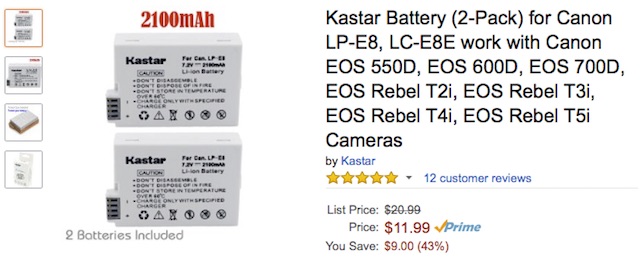
The thing is, Canon and other camera makers are using top-quality cells from premium manufacturers, so it's unlikely that cells from other makers would have higher capacity. Since battery life is a competitive spec when comparing cameras from different manufacturers, camera makers naturally want to have the highest possible battery capacities consistent with safety and reasonable cycle lives. You can to some extent trade off cycle life against higher initial capacity by using thinner electrodes to pack more surface area into the same volume. The greater surface area delivers more capacity at first, but the downside is that the thinner electrodes get used up quicker, so the battery may have a substantially shorter life. So it's possible that some battery packs may have slightly more capacity when brand new than those from the camera makers themselves, but you can pretty well count on them dying a lot sooner as a result.
What we didn't (couldn't) test
As just alluded to, a big part of the value of a battery is how long it'll last in use, day after day, week after week. This is an area where problems can particularly show up if a manufacturer has cut corners on the quality of their materials or their production processes. All cells degrade over time, but if the metals and chemicals are of lower purity (or lesser agents are substituted), or manufacturing tolerances aren't held, cell capacity can deteriorate a lot more quickly than otherwise.
Unfortunately, this is an area we're just not able to test: It would involve hundreds of charge/discharge cycles on dozens of batteries, requiring a lot of channels of automated test equipment to accumulate enough data to be meaningful. As noted above, though, some buyers of third-party products on Amazon have reported very rapid loss of capacity, even with relatively light usage.
Counterfeit chargers
Counterfeit batteries are only half of the equation, though; the market is saturated with counterfeit chargers as well. Again, the most obvious giveaway is the price; they sell for a lot less than genuine ones from the camera makers.
We didn't have the time or wherewithal to test counterfeit chargers, even to the limited extent we did the batteries, but when we cracked several open and compared them to genuine chargers, the differences were jaw-dropping. We only looked at charger models for Canon LP-E6 and LP-E8 batteries, albeit several samples of each, but the counterfeits were without exception shoddily constructed, and drastically less sophisticated than the genuine units. (I mean, drastically.)
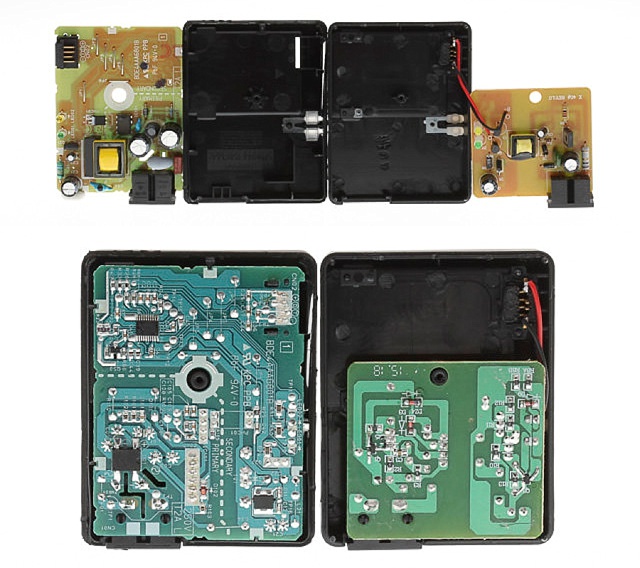
The official Canon chargers had circuit boards packed with components, including multiple integrated circuits. In contrast, the counterfeits were built with a sparse collection of discrete components, with nary an IC in sight.
Here again, you have to figure that camera makers aren't just tossing in all those parts for the sake of spending money. They'd surely be happy to save the cost, cut their prices, or make more profit, but have decided that the complexity is worthwhile, in terms of preserving battery life and protecting the consumer.
I wish I'd had the time to run electrical tests on the counterfeit chargers. Using discrete components as they did, it's almost unavoidable that tolerances wil be looser, and they'll thus be that much more prone to overcharging (or undercharging, if the designers were in fact concerned about avoiding dangerous conditions and so allowed a greater safety margin). Discrete-component charging circuits are also more susceptible to to failure from things like cold solder joints or defective components. I didn't remotely have time to trace the circuits of the counterfeit chargers, but pretty much any design built with discrete components could fail into an always-on mode from a cold solder joint. There's a lot of fail-safe margin built into IC-based solutions, and the soldering jobs on the fakes tended to be sub-par as well.
The price is tempting
You don't have to look too hard, though, to know why we're tempted by counterfeit batteries: It's the price. The same is true for third-party compatible replacements, as both sell for a fraction of the price of the OEM (Original Equipment Manufacturer) batteries. For example, a genuine Canon LP-E6 is $59 on Amazon, 3rd party units are only $14 or so, while counterfeits on eBay are $22-$35. (People are apparently willing to pay more for counterfeits than legitimately-branded third-party units, probably because people think they're getting the genuine product.) Genuine Canon LP-E8s go for $47.49, while third-party versions are as cheap as ~$4 each, and eBay counterfeits ranged from ~$11-$20. As noted earlier, some third-party batteries even claim almost 2x the capacity of the genuine articles, but there's essentially zero chance of that being the case.
How to tell a counterfeit
When you're trying to figure out whether a battery pack is counterfeit or not, it mainly comes down to the price, as all the ones we encountered were selling for well below the cost of the genuine article. If the price seems to be too good to be true, it probably is. But there's of course nothing to prevent a wiley counterfeiter from selling their packs at just enough below the price of legitimate products from the likes of Amazon or B&H that you might think they're just a particularly good deal.
Product photos for very few eBay offerings were obviously different from those of genuine batteries; the vast majority we saw looked just like the genuine article. Sloppy printing on battery cases is supposedly a giveaway for counterfeit products, but from what we found, this may no longer be the case: For the most part, the printing we saw on the counterfeits we bought was pretty clean, and there were a couple of samples that we couldn't tell from the real thing, even holding them side by side under good lighting.
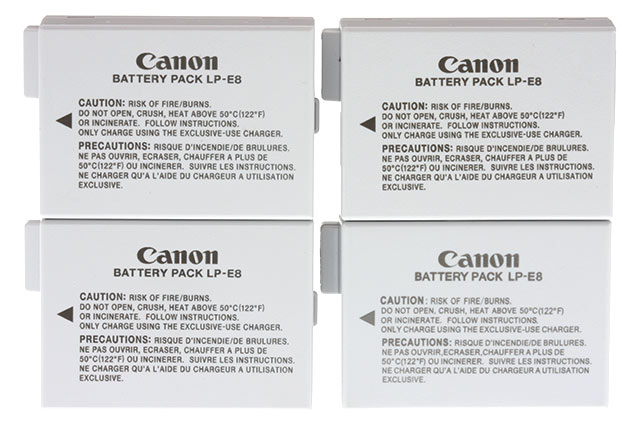
Given how convincing some of the fakes were, it seems that the only real assurance you can have that you're not getting a counterfeit product is to buy it from an authorized reseller like Amazon, B&H, Adorama or other mainstream retailers.
The bottom line
Will a counterfeit battery melt down, explode and destroy your camera? Perhaps not, else we'd be seeing daily news stories about melting cameras and exploding batteries. (Chargers may be another issue; while we didn't test them for this article, they probably have a greater chance of causing fires or other harm, given that they're the interface to the 100/110/220 volt line power, and control of charge-termination voltage is critical to safety.)
It's pretty certain that counterfeits are made to lesser quality standards, though, may lack safeguards, and are likely to have lower capacity and longevity than the genuine article. Then there's the personal question of whether you want to support counterfeiters. To our mind, third-party brands are one thing, but counterfeiters are entirely another. Third party companies at least have an identity of their own, some level of brand reputation to care about, and a legal entity in the US to look to in the event of problems. With counterfeiters, the real manufacturers are falsely hiding behind the camera companies' names and reputations, so have no accountability to produce even marginally reliable products.
Even with legitimate third-parties, though, we found that pack construction is often several (large) steps down from that of Canon, Nikon, and other mainstream companies. It's also virtually guaranteed that the cells inside aren't made with nearly the care or quality of materials found in mainstream products. We'll admit that we've used third-party batteries in our own lab in the past, especially on the lens-testing side, where we shoot many hundreds of images a week. After getting a look at what's inside the off-brand battery packs we sampled, though, we may rethink that. Also note that we're working in a lab environment, with a stack of freshly-charged packs always at the ready in our "battery corner." If we were out in the field and depending on the batteries for our only chance at critical shots, manufacturer battery packs and their accurate representations of remaining capacity would be an easy decision to make.